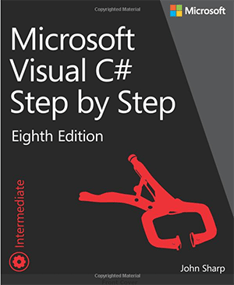 Today is our next edition of the Cimetrix Book Club. Our employees are always striving to develop their skills, share information, and keep up to date with the industry. Part of this effort includes an employee book club that involves many of our team members each month. We will cover some of their favorites from time-to-time here on our blog!
Today is our next edition of the Cimetrix Book Club. Our employees are always striving to develop their skills, share information, and keep up to date with the industry. Part of this effort includes an employee book club that involves many of our team members each month. We will cover some of their favorites from time-to-time here on our blog!
Today's book is called "Microsoft Visual C# Step by Step – Eighth Edition" by John Sharp. The book review is by Richard Andrew, a Software Engineer based in Salt Lake City, UT, USA. This book was designed to be an overview of the programming language, C# and cover the breadth of most topics while delving in depth on some of the topics. It was designed to be helpful for even the most novice developers while still being useful to advanced programmers looking to sharpen their craft. This was perfect for our group because we had a mix of aspiring developers (or developers who hadn’t spent much time programming yet), experienced developers who were new to C#, and experienced developers just looking to get better and learn new things about the language and about best practices.
This book was designed to be an overview of the programming language, C# and cover the breadth of most topics while delving in depth on some of the topics. It was designed to be helpful for even the most novice developers while still being useful to advanced programmers looking to sharpen their craft. This was perfect for our group because we had a mix of aspiring developers (or developers who hadn’t spent much time programming yet), experienced developers who were new to C#, and experienced developers just looking to get better and learn new things about the language and about best practices.
The Book was split up into four sections. The first two sections focused on general programming practices and structure that are important to any programming language but written in a way that was applicable for C#. These sections mainly focused on breadth and covering many topics. This was especially helpful for our aspiring developers and the developers who were just learning or becoming familiar with C#. For our more experienced developers, these sections were more of review or relearning what they already knew.
Section three dove deeper into more advanced programming topics and provided a good overview for some of our novice developers, but it was really geared for a more experienced developer. This section talked about generics, collections, event handling and querying expressions. Lots of new tools to add to our kits.
Section four focused primarily on building Graphical User Interfaces (GUIs) with C#, and the author specifically chose to highlight using UWP applications (Universal Windows Platform). This section on the surface seemed to be less relevant to what we were working on. But after reading and looking looking at the code behind it, it became very relatable to WPF (Windows Presentation Foundation), which is an application we use in our products. This section was also extremely helpful for anybody seeking to become Microsoft Certified. As we currently have several engineers in our group striving to become Microsoft Certified, this section was helpful preparation.
All in all this book was excellent for our team. It gave an introduction and an overview to our novice developers while still providing a lot of education to our more experienced developers. A great thing about this book were the examples in each section that, when we really dug in, gave us rich knowledge and context to everything the author was trying to convey. You really get out what you put into the study of this book.




